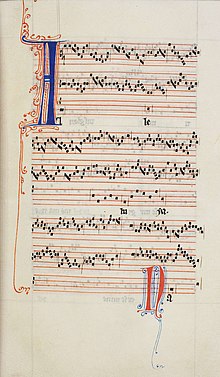Modal notation

The modal notation is a system of notation of polyphonic music in Western Europe during the Notre-Dame-era (12th century to the early 13th century) was in use and from the square notation has evolved.
In European music history , the modal notation was the first system that made it possible to define rhythms, i.e. a fixed sequence of long and short note values . This was a prerequisite for polyphonic music - in contrast to monophonic music such as the Gregorian chant - to be comprehensibly written down.
In contrast to modern music notation, no individual note values could yet be represented. Rather, the modal notation was based on six different rhythmic formulas ( modes ), which were repeated over and over again in the course of a piece . The rhythm based on this is called modal rhythm or modal rhythm.
The six modes were represented as a sequence of ligatures (notes connected by a bar) and individual notes. The pattern of the sequence of ligatures and single notes indicated the mode in which the piece was to be sung.
At the beginning of the 13th century, the modal notation was replaced by the mensural notation , with which considerably more differentiated rhythms could be represented.
literature
- Willi Apel: The notation of polyphonic music. VEB Breitkopf & Härtel, Leipzig 1962, ISBN 3-7330-0031-5
- Möller / Stephan (ed.): New handbook of musicology. Medieval music. Vol. 2. Laaber, Laaber 1991